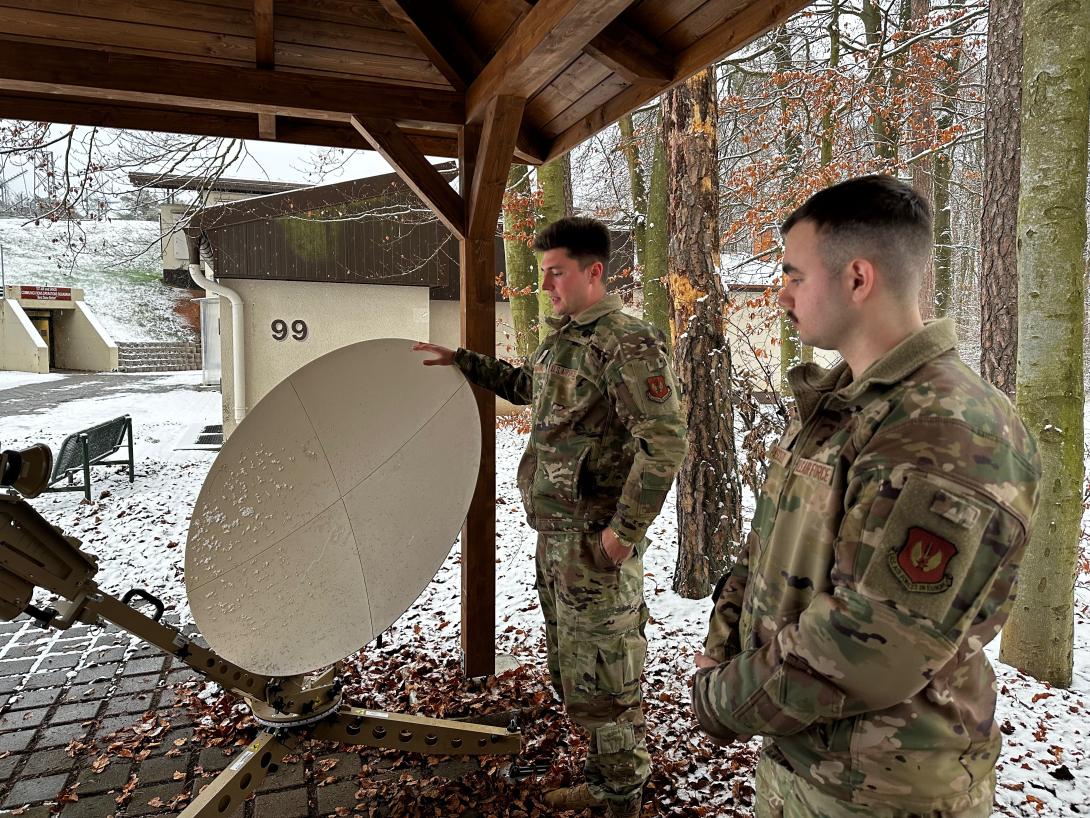BlackNet Offers Groundbreaking Transport for All-Domain Communications and Data
The U.S. Air Force’s 1st Air and Space Communications Operations Squadron (1st ACOS), stationed at Ramstein Air Base, Germany, and part of U.S. Air Forces Europe and Africa (USAFE), is progressing adroitly on BlackNet, a groundbreaking transport layer that will support all kinds of communication methods and command and control across different enclaves.
Engineered for a dispersed, contested environment, BlackNet integrates an abundance of communications choices such as military satellite communications, Starlink, fiber optics, commercial cellular and Ethernet connections.
And while the Air Force’s BlackNet that has supported JWICS—the Joint Worldwide Intelligence Communications System—is nothing new, how the 1st ACOS is integrating other enclaves, in addition to JWICS, and the various communication methods, is groundbreaking.
“We’ve used it to extend JWICS, but it is not just JWICS anymore,” said Lt. Col. Phillip Alvarez, 1st ACOS commander, speaking with SIGNAL Media during a December 4 visit at Ramstein. “We have been able to extend any enclave—SIPR [Secure Internet Protocol Router Network], NIPR [Non-classified Internet Protocol Router Network], special access, coalition, it doesn't matter. If you want it, we can provide it. It is no problem.”
“In the past, BlackNet was rapid agile just for JWICS,” said Joseph Awua, branch chief, intelligence systems infrastructure, 1st ACOS. “But now it is using it for multiple ISR systems across the theater in Europe and in Africa.”
BlackNet also provides command and control capabilities—such as the Global Command and Control System, or GCCS—a secure bedrock layer, and can provide an environment as well for the Advanced Battle Management System (ABMS) and its associated digital infrastructure (ABMS DI), the Air Force’s contribution to the Defense Department’s Combined Joint All Domain Command and Control environment.
Already, 1st ACOS has supported or enabled six different combatant commands with BlackNet, Col. Alvarez said. “We have ramped up operations across the board. We have done 52 TDYs [temporary duty assignments] this year, for operations, exercises and other events.”
The 1st ACOS engineered a solution based on the routing technique of multiprotocol label switching, or MPLS, and virtual routing and switching, VRF, combined with robust security and other aspects. “We use MPLS and VRF technology, and basically, it creates the lanes so that way there is no bleed over.” Notably, with that level of security, the dedicated BlackNet transport layer can ride securely on top of commercial provider solutions outside of the United States, another groundbreaking step.
And while the basic technology existed for 10 years, it was a bit of a challenge to engineer BlackNet to work with the various enclaves and integrate the communication methods. “As it is has grown and evolved, there are new requirements,” explained Senior Airman Lucas Browning, intelligence systems network technician. “The challenge was working with the existing technologies to accommodate that and also thinking outside the box. Figuring out if we need to set it up ‘here,’ how are we going to set it up and what do we need to change. It was kind of an oval, trying to get to a circle properly. The foundation was already there, but it always having to tweak it.”
The result is something that is straightforward and fast to employ. “You don’t have a user account,” the commander explained. “Your account is the enclave that you already have. You are not filling out a ‘2875’ to get BlackNet. BlackNet is just transport. It is like saying do I need an account to use the hotel WiFi. You don't. It is just there. And we created security on top of it just to make sure we're good.”
Additionally, the unit brought the solution to the Heavy Rain Exercise III, an event designed to test operations in highly contested environments. Airman First Class Tyler Pascuzzi, intelligence systems client technician at the 1st ACOS saw firsthand how secure, easy and successful it was to employ BlackNet under such a rough operating environment. “As I watched Airman Browning configure routers to switch between networks, it just honestly blew my mind how easy it was to failover between networks and keep the comms [communications] up.”
For Master Sgt. Michael Falleroni, section chief, theater intelligence systems operations, who joined the 1st ACOS about six months ago, coming from the tactical community, BlackNet is akin to solutions seen in that environment. “I’m finally wrapping my head around the mission, but I'm coming out of the tactical community, where we are doing a lot of similar things,” he shared. “We are typically ahead of conventional forces on these types of bleeding edge networks. But hearing about BlackNet in this unit being so far along in the development of it, and how robust it is already, is just extremely impressive.”
However, given BlackNet’s greater range as a capability, Air Force leaders have to work out how it is programmatically aligned, moving out from being just a military intelligence platform for JWICS, generally under the Air Force’s staff A2, and moving more into command, control, communications aspects typically under A6 responsibilities.
Lt. Gen. Leah Lauderback, the Air Force’s deputy chief of staff for ISR and Cyber Effects Operations to better understand our mission and challenges along with Ken Autry and other leaders who are visiting Ramstein this week to iron out any “gaps,” Col. Alvarez noted.
“We have been working with the A6 now on trying to do that transition, as it is not just ‘JWICS-centric anymore,’” he shared. “As it has become more open to everyone, this should be more of an ‘A6 capability’ versus an ‘A2 capability.’ And they have agreed. They're taking it on. We are working in conjunction with the A6 and the A2 and with ABMS DI to look at what that transition will look like over the next few years.”
The colonel’s hope is for ABMS DI to consume what the 1st ACOS has already built, he said.
“And give us the authority to continue to do so and then give us NOC [network operations center] and SOC [security operations center] responsibilities to manage BlackNet for the theater, because we already have an 80 to 85% solution of what they were looking for.”
The 1st ACOS is also meeting with the 700 Air Support Squadron (the 700 ASUS) to share how Ramstein is managing BlackNet, its architecture and strategize together on future design advancements.
So far, the advancement of BlackNet over the last year or so has been fast. After Air Force leader Danny Hotzman granted BlackNet an initial authority to operate (ATO) in August of 2022, the commander and the airmen worked hard to meet this past summer the additional conditions that Holtzman had set.
“When I came in to the position, I advocated to get Mr. Holtzman to come take a look at BlackNet,” Col. Alvarez said. “And within two months, he gave us the initial ATO. There were 10 conditions that we needed to meet to get fully to ATO and we met that in July of this year. That is the legitimacy that BlackNet provides.
Engineered for use in the European and African areas of responsbility, BlackNet could be applied easily to the Indo-Pacific and other regions, Col. Alvarez continued. Leaders from the unit are already speaking with Pacific Air Forces and the U.S. Indo-Pacific Command leaders.
“We have essentially applied, no kidding, real world ISP [Internet Service Provider] configurations on a DoD enterprise, and that allows us to pretty much simulate what AT&T, Verizon, Viacom or whomever do, created just for the Air Force to allow USAFE and Air Forces Africa to put anything they want, anywhere, within AOR, without any issues,” said Awua.
“It is not just JWICS anymore. [With BlackNet,] we have been able to extend any enclave—SIPR [Secure Internet Protocol Router Network], NIPR [Non-classified Internet Protocol Router Network], special access, coalition, it doesn't matter. If you want it, we can provide it. It is no problem.




Comments